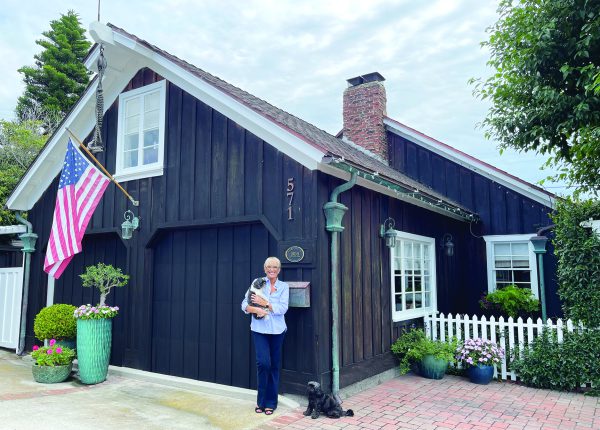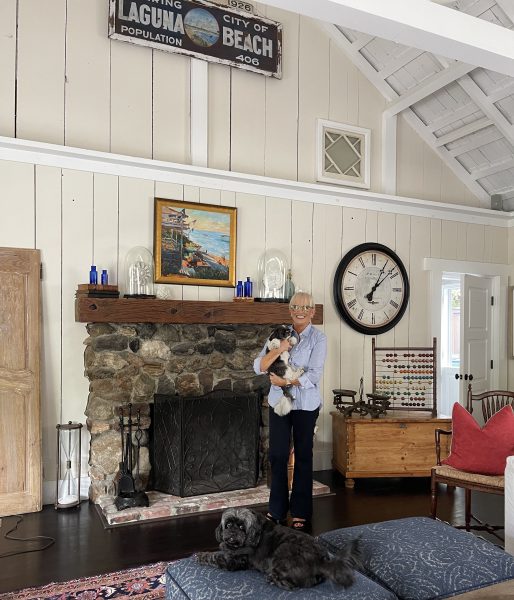571 Graceland Dr.
By Hunter Fuentes and Jon Stordahl

You don’t always find your dream house; sometimes, it finds you. Shelley Katke raised five children in a large home in San Clemente. In 2014, she was beginning a new chapter in her life. Shelley started to search for a new home and fell in love with the first one she was shown, 571 Graceland. The previous owner was a talented designer who had completed an extensive and tasteful remodel. Shelley always loved the energy of Laguna but had never really considered living in a historic home. She was enchanted. This house spoke to her.
Julia Morgan, the pioneering female architect best known for her work on Hearst Castle, once noted that “Architecture is a visual art, and the buildings speak for themselves.”
Some have more to say than others. 571 Graceland has quite a lot to say.

Proudly standing as one of the oldest homes in town, the original board and batten rectangular structure (about 40 feet by 20 feet) was constructed by Joseph Yoch around 1895, not as a home but as a multi-purpose building to serve many needs in the growing community. Yoch was a visionary who recognized the uniqueness and possibilities of Laguna. He invested most of the capital that got the young town started. The little building was erected next to the original Hotel Laguna, the predecessor to the grand inn that stands at the corner of Laguna Avenue and Coast Highway. In its early years, it was called the “Pavillion” and later the “Art Gallery.” The historic assessment of the building describes it as having served as “the unofficial city hall, church, dance hall, funeral parlor and wedding chapel.”
It was also the first incarnation of the Laguna Beach Art Gallery, hosting its first exhibit in July 1918. The painters who established Laguna Beach as a noted art colony, Cuprien, Hills, Wendt and Kleitsch among others, hung works on these walls. Thousands of visitors, including such notables as President Wilson and Helen Keller, visited the Gallery each year. As the town grew in size and reputation, it outgrew the little building and was replaced by the current Laguna Art Museum, built on Cliff Drive in 1929. This led to both a new purpose and location for the old Gallery.
Frederick Schwankovsky, a leader in the town’s artistic community, offered to give the little building a new home on an open lot next to his residence on Graceland Drive. It was moved from Coast Highway, where it had stood for almost three decades, to its new setting, where it served as the site of the “Little Art Theater.” Many structures were moved around in Laguna and in the days before slab foundations, it was relatively common to transport a building to a new site. At the time of its relocation, the building only had three sides to it. Actors, under the direction of Wayne Moore, performed in the moving structure on the open side for a crowd of hundreds who trailed the Gallery as it navigated to its new home. Only in Laguna! For years, scores of people filled the theater for multiple performances every month until changes in the fire codes led to the forced closure of the theater in the late 1930s. Schwankovsky and his wife, Nellie Mae, converted the building into their residence and his art studio. They added a new wing to the original structure that included a large kitchen and several bedrooms. Windows and doors were relocated to better serve the needs of the various rooms. A dramatic two-sided fireplace was added and a curved stairway leads down to a private bedroom suite. Part of the stairway wall is made from the front door of the original Hotel Laguna, purchased for just fifty cents. The old Gallery space remains the heart of the house. The raised theater stage forms a beautiful, elevated nook at one end with a dramatic loft above. With all of its interesting characteristics, the home would go on to be featured in an April 1965 KCOP television program, “Resources of Southern California.” Hosted by Schwankovsky’s daughter, Betty, the episode featured California Historical Landmarks and used the home as an example of how a building could be preserved as part of the state’s history.
Schwankovsky was a Laguna character. He was a talented artist, a Theosophist, a devotee of Yoga and a political radical. He was also an art teacher at Manual Arts High School in Los Angeles, where his most noteworthy student was the young Jackson Pollock, who considered “Schwammie” one of the most significant influences in his life. Schwankovsky even directed the Pageant of the Masters in 1946, when it was revived after a wartime hiatus. He lived in the home well into the 1960s and died in Humboldt County in 1974.
The house has only had a handful of owners since then. Shelley says the key to living in an old house is to embrace the history and not try to overdo it. Her nine grandkids fill the home with laughter and excitement during summer and holiday visits, the echo of those audiences from years past. Her extensive art collection fills the walls and the old Gallery lives on. Every building has a story; this one celebrates and embraces its numerous roles, worthy of many generations of standing ovations.
Hunter Fuentes is a local resident and realtor with Compass in Laguna Beach, specializing in historic architecture. Jon Stordahl has lived in Laguna for over 20 years and is a retired history teacher.





Just wanted to say I love the painting over Your mantle! The original was painted by local “surfer artist” Pat Tobin. You obviously have excellent taste in art! Pat who grew up in Laguna, class of “68” and was a legendary “big wave” rider who spent years in Central Mexico. Tobin was one of the original members of group of surfers who “discovered” the perfect wave. Chronicled in surfer magazine in the 70’s by Kevin Naughton & Craig Peterson. That original story brought an end to Pat and his crews private stash as the word on PETACALCO, Mexico got out and droves of surfers began showing up to “attempt” to ride “insanity” as the outside break came to be known. This story was revisited in Naughton & Petersons’ book “SEARCH FOR THE PERFECT WAVE”.
Unfortunately, Pat Tobin passed way too early in 2006. Pat’s art does live on and is well represented in many prints of Laguna’s beaches and his other travels at Tuvalu in Laguna, as well as other galleries and shops.
Anyway, loved seeing the image of RUBY Street hanging over Your fireplace!